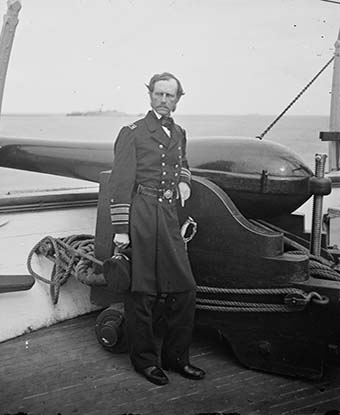Last updated: December 6, 2019
Person
John A. Dahlgren

Library of Congress
John A. Dahlgren was born in Philadelphia in 1809 and joined the Navy as a midshipman in 1826. After many years at sea with the coast survey, he was assigned in 1847 to the Navy’s Ordnance Bureau in Washington, D.C. He was best known for developing a series of heavy cast-iron smoothbore cannons that became known as Dahlgrens. He became head of the Washington Navy Yard in April 1861 and head of the Navy’s Ordnance Bureau in 1862.
With his promotion to Rear Admiral, Dahlgren assumed command of the US Navy’s South Atlantic Blockading Squadron on July 6, 1863. He directed the naval bombardments of Confederate Batteries Wagner and Gregg in support of the Union Army’s assaults on Morris Island beginning on July 10, 1863 and resulting in the evacuation of Confederate forces from the island on the night of September 6-7, 1863. On the morning of September 7, Dahlgren demanded the surrender of Fort Sumter. When his demand was refused, he ordered an amphibious assault by sailors and marines to take place on the night of September 8-9. The Confederates were ready and waiting, easily defeating the attack and inflicting 127 Union casualties with no losses of their own.
A similar attack had been planned the same night by Union Army Brigadier General Quincy A. Gillmore from Morris Island but was called off when the Army troops spotted the uncoordinated Navy attack failing. Much finger pointing followed the debacle on the Union side for several months. However, Admiral Dahlgren managed to keep his job. Cooperation between Dahlgren and the Union Army remained rocky throughout the ensuing siege period. In March 1864, Dahlgren learned of the death of his son, Colonel Ulric Dahlgren in a cavalry raid on Richmond, Virginia in which his son may have had orders to assassinate President Jefferson Davis and members of the Confederate cabinet. The episode, known as the Dahlgren Affair, is still shrouded in mystery. Dahlgren's eldest son, Charles Bunker Dahlgren, served in the US Navy during the Civil War, participating in the Siege of Vicksburg and also serving under his father in Charleston Harbor.
In addition to helping seal off Charleston, he aided General William T. Sherman in the capture of Savannah in 1864. With the withdrawal of Confederate forces from Fort Sumter and the Charleston area on the night of February 17, 1865, Admiral Dahlgren was at last able to lead his fleet into Charleston Harbor.
When he was relieved of the command of the South Pacific Squadron in 1869, a post he held for two years, he returned to the Washington Navy Yard where he served until his death in 1870.
